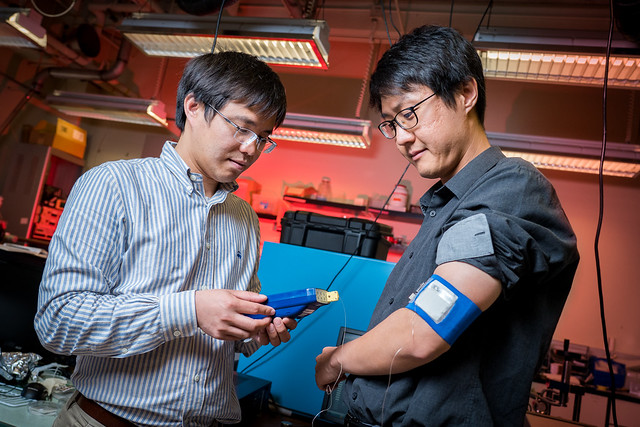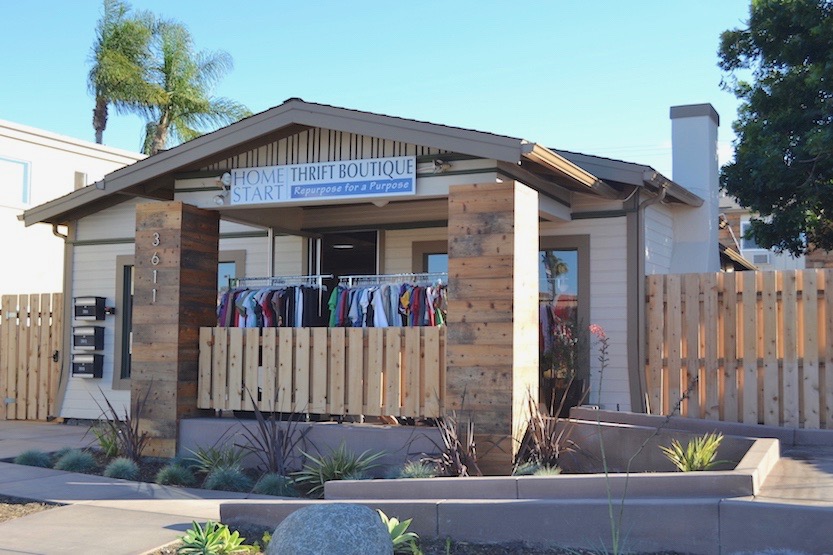Daily Business Report-June 7, 2019
Renkun Chen (left), UC San Diego professor of mechanical and aerospace engineering, measures the temperature of the prototype cooling/heating system worn by Sahngki Hong (right), the study’s first author. (Photos by David Baillot/UC San Diego Jacobs School of Engineering)
Research
Wearable cooling and heating patch could
serve as personal thermostat and save energy
Engineers at the University of California San Diego have developed a wearable patch that could provide personalized cooling and heating at home, work, or on the go. The soft, stretchy patch cools or warms a user’s skin to a comfortable temperature and keeps it there as the ambient temperature changes. It is powered by a flexible, stretchable battery pack and can be embedded in clothing. Researchers say wearing it could help save energy on air conditioning and heating.
The work is published May 17 in the journal Science Advances.
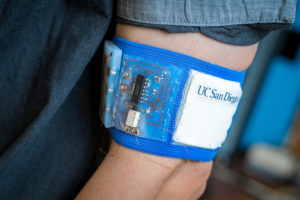
“This type of device can improve your personal thermal comfort whether you are commuting on a hot day or feeling too cold in your office,” said Renkun Chen, a professor of mechanical and aerospace engineering at UC San Diego who led the study.
The device, which is at the proof-of-concept stage, could also save energy. “If wearing this device can make you feel comfortable within a wider temperature range, you won’t need to turn down the thermostat as much in the summer or crank up the heat as much in the winter,” Chen said. Keeping a building’s set temperature 12 degrees higher during the summer, for example, could cut cooling costs by about 70 percent, he noted.
There are a variety of personal cooling and heating devices on the market, but they are not the most convenient to wear or carry around. Some use a fan, and some need to be soaked or filled with fluid such as water.
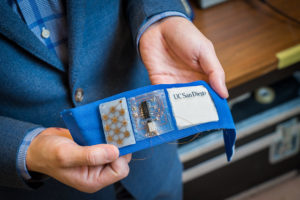
Chen and a team of researchers at the UC San Diego Jacobs School of Engineering designed their device to be comfortable and convenient to wear. It’s flexible, lightweight and can be easily integrated into clothing.
The patch is made of thermoelectric alloys—materials that use electricity to create a temperature difference and vice versa—sandwiched between stretchy elastomer sheets. The device physically cools or heats the skin to a temperature that the wearer chooses.
“You could place this on spots that tend to warm up or cool down faster than the rest of the body, such as the back, neck, feet or arms, in order to stay comfortable when it gets too hot or cold,” said first author Sahngki Hong, a UC San Diego mechanical engineering alumnus who worked on the project as a PhD student in Chen’s lab.
______________________
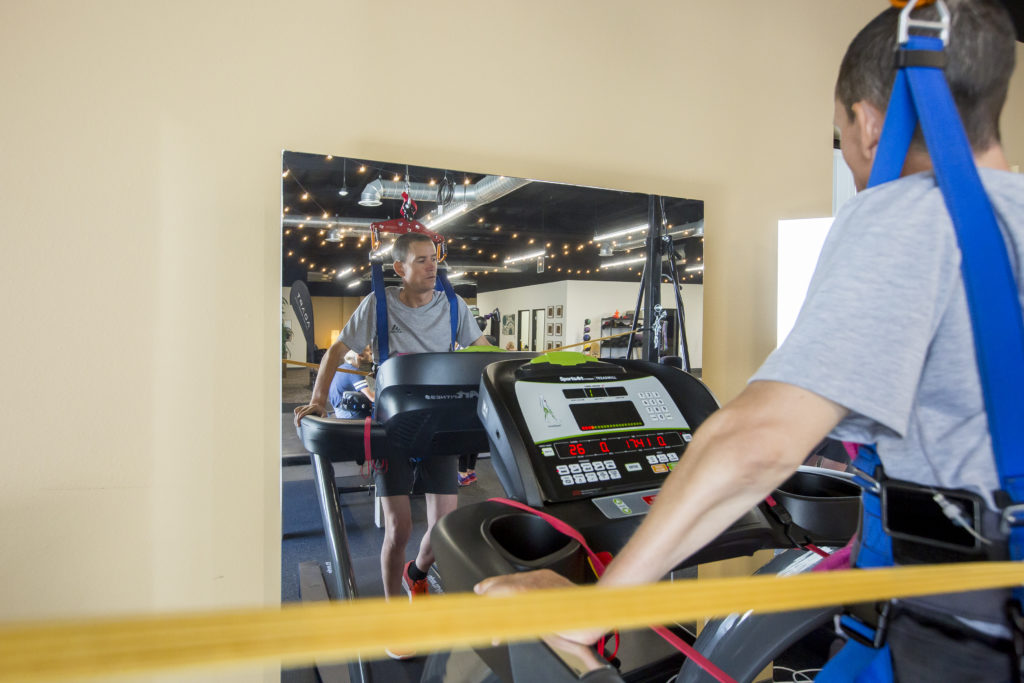
Fifth annual North County Regional
Multiple Sclerosis Expo set for Saturday
Adapt Functional Movement Center, a nonprofit rehabilitation center, will host the fifth annual North County Regional Multiple Sclerosis (MS) Expo in collaboration with Healthcare Journey and UC San Diego Health. This free, informative and interactive event on Saturday will feature presenters who will share the latest discoveries and complementary therapies for neurodegenerative disease recovery and rehabilitation. Attendees will have an opportunity to explore interactive exhibits focused on sustaining health and wellbeing.
Also, attendees will enjoy a raffle drawing with an opportunity to win prizes valued to $4,000. Prizes include Adapt’s recovery services, Powerdot Neuromuscular stimulation devices, Muse EKG headbands for meditation training, Float Spa passes and an Emu Trike mobility scooter. Lunch is hosted and will be provided by Leilani’s Food Truck – Hawaiian Cuisine.
The following keynote speakers will present:
Dr. Revere (Rip) Kinkel, UCSD Clinical Neurosciences Director, Professor of Neurosciences, Multiple Sclerosis Center Director
Dr. Jennifer Graves, Director of the Rady Children’s Hospital Pediatric MS Clinic and Director of Neuroimmunology Research at UCSD
John Monteith, Founder and Executive Director at Adapt Functional Movement Center
EVENT SCHEDULE:
12-noon Expo Opens, Lunch Served
2 p.m. Raffle Drawing
3 p.m. Keynote Presentations
5 p.m. Expo Closes
Workshop speakers and demonstrations include LIGHT, M.Y. Therapy Healing, PowerDot, and A. Noone Feldenkrais. Attendees will interact with PowerDot, a neuromuscular electric stimulator, as well as learn more about guided imagery therapy, and other treatments and movement techniques in Adapt’s Ground Therapy Room and in the Stim Lab. Guests will also learn about Adapt’s method for physical, mental and community health.
More than 150 guests are expected to attend the expo. Advance registration is recommended. Registration will also be available at the door. Visit healthcarejourney.com/expo to register.
______________________
PUC denies SDG&E request
to eliminate high usage charge
San Diego Gas & Electric says tens of thousands of its customers may continue to see a High Usage Charge (HUC) on their bills after the California Public Utilities Commission (CPUC) denied the utility’s request to have the state-mandated charge eliminated or suspended. Last summer, more than 120,000 customers were impacted by the HUC.
The HUC was incorporated into SDG&E’s billing structure in late 2017 per state requirements to encourage energy conservation. Customers incur the charge after using high amounts of electricity – more than 400 percent of their baseline allowance – to power their homes. Last summer, as multiple heat waves hit, and customers began using more energy to cool their homes, many customers began to see their bills spike.
“Last summer was a challenge for our customers, particularly for people who experienced dramatic increases in their bills due, in part, to the High Usage Charge,” said Scott Crider, SDG&E’s vice president of customer services. “We heard their concerns and took action to have the HUC removed on their behalf, but unfortunately the CPUC did not approve our request.”
In the coming months, the company said, it will pursue other bill relief options such as eliminating seasonal pricing changes. Under the seasonal pricing structure, higher electricity prices go into effect during the summer months (June – October). Eliminating seasonal pricing would require CPUC review and approval.
Residential customers can avoid the HUC by enrolling in one of several Time-of-Use (TOU) pricing plans which are not subject to the charge. More information about TOU plans can be found at sdge.com/whenmatters.
______________________

Supervisors vote to buy 123 acres
for Ramona Grasslands Preserve
County supervisors voted unanimously Wednesday to buy 123 acres of open space and habitat to add to the county’s 3,490-acre Ramona Grasslands Preserve. The preserve is part of the county’s Multiple Species Conservation Program (MSCP) and includes important habitat like coastal sage scrub and oak woodlands, a large portion of Santa Maria Creek, grasslands, wetlands, vernal pools, 409 different plant species, 23 butterfly species, 21 reptile species, 37 mammals, six types of amphibians and more than 100 types of birds.
The preserve also includes trails for hikers, bicyclists and equestrians to enjoy, although not all of the preserve’s acreage is open to the public. The preserve is managed by the county’s Department of Parks and Recreation.
The Board of Supervisors voted 4-0 to spend roughly $950,000 to buy the land and add it to the northern portion of the preserve. Supervisor Greg Cox was absent, attending a speaking engagement with the National Association of Counties in New York.
The new 123 acres are located north of Old Survey Road and east of Bandy Canyon Road in Ramona.
______________________

Study finds men’s voices
still dominate in movie reviews
If you seek out a professional critic’s review of “Rocketman” or the new “Toy Story” movie before deciding whether to see them this summer, the odds are you’ll be getting the opinion of a man.
A new report out of San Diego State University finds men account for two-thirds of all film reviewers in the United States, and that it may make a difference in what gets mentioned in their reviews and even whether they recommend the movie.
The findings come from Martha Lauzen, executive director of SDSU’s Center for the Study of Women in Television and Film. In this year’s edition of an annual study, Lauzen found that in 2019, men comprise 66 percent of film reviewers working for print, broadcast and online outlets in the U.S. compared to just 34 percent for women. In 2018, women accounted for 32 percent of reviewers.
______________________
Cubic gets contracts to deliver training
support for Indo-Pacific Region customer
Cubic Corporation’s Cubic Global Defense business division was awarded several contracts totaling approximately $150 million from various customers in the Indo-Pacific (IPAC) region to provide Air Combat Maneuvering Instrumentation (ACMI), training support for Combat Training Centers and deliver upgrades and maintenance services for the region’s live fire ranges. The total value of the awarded contracts includes options to extend as well as support for future overseas exercises and additional services where needed.
“We are committed to delivering the most advanced training systems to ensure our allies have the ability to establish realistic training environments that accurately simulate the complexities of combined arms operations,” said Mike Knowles, president of Cubic Global Defense. “We are pleased to leverage our worldwide expertise as the leading provider of instrumented tactical engagement systems to support our customer in the IPAC region.”
Cubic’s services for Combat Training Centers will include training support in IPAC as well as maintenance and supply of Multiple Integrated Laser Engagement Systems (MILES). Additionally, Cubic will design, build and provide ongoing comprehensive maintenance support for live fire ranges.
______________________

Influenza virus mutation could be
secret to better egg-based seasonal vaccines
When is a mutated virus a good thing? When the mutation could make flu shots more powerful.
Scientists at Scripps Research have found that a mutation called G186V could be a useful addition to the H3N2 influenza vaccine. As they reported in Cell Host & Microbe, preparing a seasonal flu vaccine with the G186V mutation may prevent a vexing problem that commonly occurs during the vaccine manufacturing process.
“This study gives us a roadmap to suggest how to improve the vaccine,” says Ian Wilson, D.Phil., Hansen Professor of Structural Biology at Scripps Research.
Wilson co-led the study with Chris K.P. Mok, PhD, of The University of Hong Kong and the First Affiliated Hospital of Guangzhou Medical University. Their work builds on a 2017 study that revealed that the common practice of growing the flu vaccine in eggs leads to a mutation called L194P, which keeps the vaccine from working as well as it should in humans.
______________________
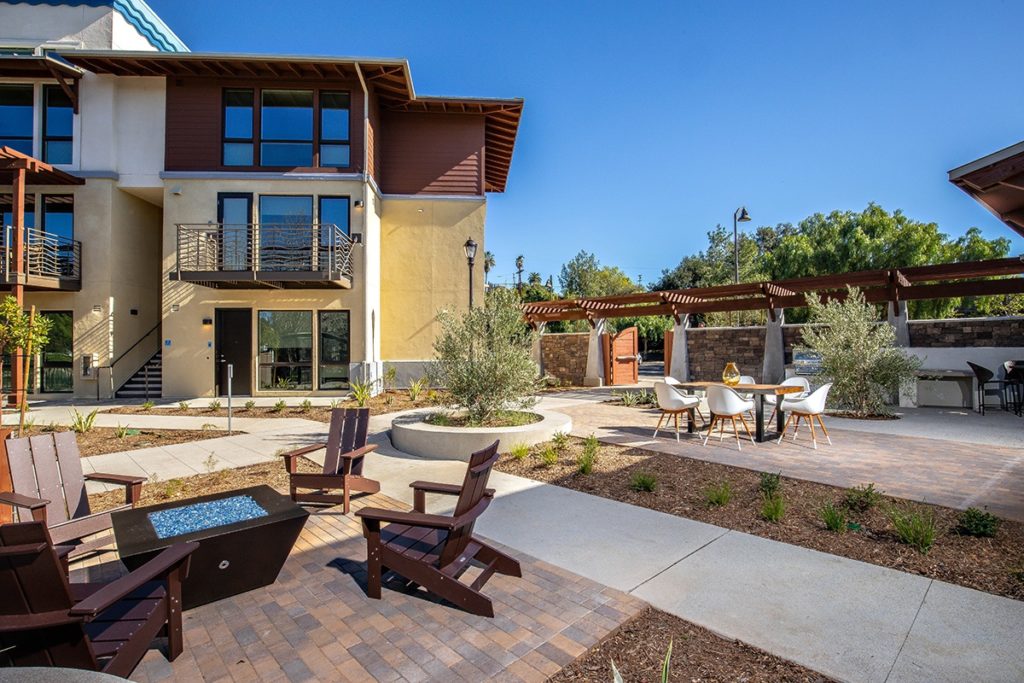
Pathfinder Partners completes
construction on Creekside Apartments
Pathfinder Partners has completed construction on Creekside Apartments – a new 41-unit multifamily community in Vista, retaining San Diego-based Sunrise Management to oversee all marketing/branding, leasing and day-to-day operations.
Now leasing, the community features open concept floor plans – ranging in size from 480 to 1,135 square feet with studio, one- and two-bedroom options. All homes have washer/dryers, wood-style plank flooring, quartz countertops, floor-to-ceiling windows and amply sized kitchens with energy efficient stainless steel appliances.
The property is located within the Vista Village Shopping Center, next to Frazier Farms Market with direct access to the adjacent creek and walking trails.
Matt Quinn, vice president of Pathfinder Partners, said his firm partnered with Silvergate Development to develop the complex, which has resort-style amenities including a high-end club house and lounge and an outdoor area complete with barbecues, fire pit and complimentary Wi-Fi. Pathfinder acquired the 1.5-acre parcel in November 2016 and began construction in 2017.

